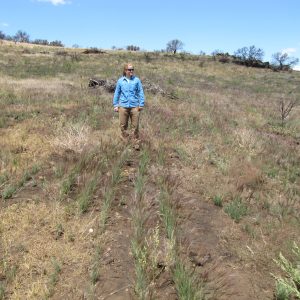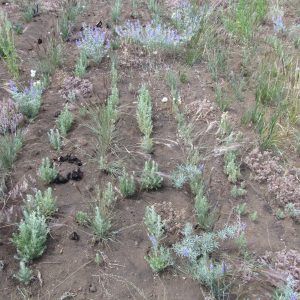Seed collection continues to be at the forefront of my activities in Alturas, but I have been able to find time to go out and learn about other projects as well. During the past two weeks I have worked with a rare plant monitoring team from the US Forest Service, banded ducks and geese at the Modoc National Wildlife refuge, electroshocked fish with the California Dept. of Game and Fish, and worked with various people within my BLM office on their current projects. It has been very rewarding to continue pushing ahead with my project while getting to help out with others.
This past week I was able to go out with my mentor to an area that had burned last year and then been seeded after the fire. The fire had burned very hot, and only a few carcasses of junipers were left in much of the area. Driving toward the hillside where the seeding had taken place, we could see that it was dominated by patches of purple. As we drew closer, we could see that the patches were huge numbers of silvery lupine (Lupinus argenteus var. heteranthus) in bloom. There was also a lot of goosefoot (Chenopodium spp.), Phacelia spp., and Basin wildrye (Leymus cinereus). We got out to take a closer look and could see neat rows of squirreltail (Elymus elymoides), and tiny Mountain big sagebrush (Artemesia tridentata ssp. vaseyana). These were the species that had been planted to previous fall, and they seemed to be thriving after the long, wet spring. It was really exciting to see the sagebrush seedlings because no one was sure how well they would do from seed. Another interesting things we noticed was that the weeds did not seem to do as well in the seeded areas when compared to the non-seeded areas right next to them. Scotch thistle (Onopordum acanthium) and cheatgrass (Bromus tectorum) are major problems inthe area, especially following fire, but they did not seem to establish in the seeded areas. It was hard not to get too excited about these results because it had been such an unusually wet year and because two years after a planting is generally a better indicator of sagebrush seedling success, but it was still great to see that this seeding was showing positive results and that in this case, a post-fire treatment was making a difference in rangeland health.

- Rows of squirreltail and sagebrush seedlings
- Rows of seedlings planted last fall
- On right: squirreltail and sagebrush seedlings. On left: scotch thistle and cheatgrass dominate



